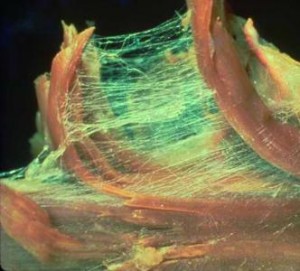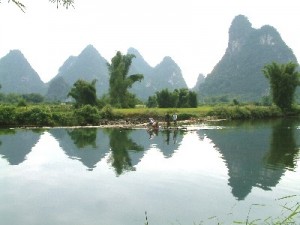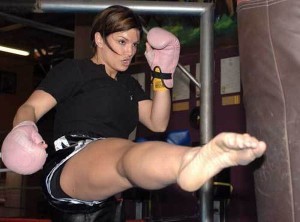Josh Leeger turned me on to a series of articles which are using a new definition of Fascia. This article is particularly worth reading:
Fascial Fitness: Fascia oriented training for bodywork and movement therapies, by Divo G. Müller and Robert Schleip.
Many people I've shown the article to have commented that one of the authors is into a painful type of bodywork called
Rolfing, and they have suggested that the authors may have created a
Rolfing centric view of fascia. Strangely no one has pointed out that the other author is into
Continuum, which is a very watery type of movement exploration.
You'll get the new definition of
fascia by just reading the article, so I'm not going to try to nail it down, but readers should know that the old definition was a description of the clear or translucent film that surrounds all muscle. The new definition includes tendon and ligament and sees all that juicy stuff as a single organ.
Whatever, right? But what
is important about this new article, and this new approach, is that it uses clinical language and conforms to kinesiology standards. Until now there was no clinical explanation of how external martial arts work that any of us could use when talking to a physical therapist. That's going to be a big change.
 Fascia?
Fascia?The article explains that tendons and ligaments themselves can take load and can spring. What the authors don't seem to understand is that it is through the natural spirals of the body that all of these soft tissues function together. They don't seem to realize that the reason they are getting these springy dynamic results from slow holistic lengthening is because their method builds on these underlying spirals. Spirals are there in shortened positions too, as anyone who does whole body tie-up and throw techniques (think: Aikido) can tell you.
So, it's a good start. It primarily deals with what we call in both internal and external martial arts, "the foundation." That is the ability to get in and out of a range of deep, long, loaded, and spiraled
stances while using smooth (wood), explosive (fire), fluid (water), and hard-solid (metal) movement qualities. "The foundation" is what I usually refer to in this blog as "jing training," the first level of internal martial arts. It is also commonly referred to in martial arts lingo as "the benefits of good structure."
The authors lose a few points in my book at the end of the article when they say this training, "should not replace muscular strength work, cardiovascular training, and coordination exercises." That statement muddies the issue. All that stuff is just included in basic Shaolin, it's already complete. If we are building this "foundation" for learning Tai Chi, Bagua, or Xinyi, then we are going to leverage these underlying spirals to allow us to reduce muscular "strength" and discard the torso tension usually associated with "coordination exercises."
The author, however, should get extra credit for hinting at methods for developing higher levels of internal martial arts. For instance, take the "ninja principle" all the way out, and the body becomes so light and quiet that our experience of the physical body becomes totally empty
(xu). Or take the idea of fluid movement all the way out, and ones habits of coordination and resistance become baby-like, unconditioned
(ziran).
The Proprioceptive Refinement section of the article is the most interesting. They discuss the, "need to limit the filtering function of the reticular formation." This refers to a part of our brain which we can train to pay attention to certain kinds of nerve stimuli and ignore others. Muscles transmit information slowly, that's why we need to turn them off and pay attention to other stimuli-- and that's the very mechanism which can make it is so easy to manipulate someone who is, in martial arts lingo, "too stiff." Eventually we want to
turn off most of our 'inside the body sensors' and
turn on most of our 'outside the body sensors.' The authors correctly identify the problems with doing any movement exactly the same way over and over, namely that we become insensitive to small errors which then become habituated.
This is why it is so important that our forms are empty! By cultivating emptiness, our movement is unconditioned by our mind. On the other hand, always thinking about a specific and exact application of a technique, will turn us into robots.
Qi has no memory! To practice martial arts with qi is to be continuously spontaneous.
To quote the
Daodejing:
To be preserved whole, bend.
Upright, then twisted;
To be full, empty.
What is worn out will be repaired.
Those who have little, have much to be gained. Having much, you will only be perplexed!
:5
 Fascia?XX
Fascia?XXlt;*/%.$2%,+C
6*-4+%=<:4<*-,%:2,+.?25%@$,;>%4-,/"$#-:4<*-,%
2,-".".?%-./%4$,/".-2"$.%+Z+,4":+:


 If you've ever been around teens or tweens, or were one yourself at some point, then you are familiar with 'discarding yes and no.' It is a look they give you that tells you they aren't listening, don't really care to be listening, and many not even be aware that you exist at all. Or as we use to say in Australia, 'I just couldn't be bothered.'
If you've ever been around teens or tweens, or were one yourself at some point, then you are familiar with 'discarding yes and no.' It is a look they give you that tells you they aren't listening, don't really care to be listening, and many not even be aware that you exist at all. Or as we use to say in Australia, 'I just couldn't be bothered.' Secret teachings take a lot of abuse. Keeping secrets is widely denounced as a moral offense against modernity. But the truth is, the real secrets keep themselves. Secret teachings are concepts, revelations, and experiences which can not be taught. I can talk about them. I can show them. I can write about them. And to a certain extent, my actions might help transmit them. But it is just as likely that I'm confusing people and sending them off in the wrong direction. Secret teachings have to be discovered. And for such a discovery to happen there has to be a particular openness, a certain milieu, a series of experiences, and a perceptiveness about where to look and what not to do when the secret is found. The dark irony is that people are discovering these treasures all the time and then just burying them again, unaware.
Secret teachings take a lot of abuse. Keeping secrets is widely denounced as a moral offense against modernity. But the truth is, the real secrets keep themselves. Secret teachings are concepts, revelations, and experiences which can not be taught. I can talk about them. I can show them. I can write about them. And to a certain extent, my actions might help transmit them. But it is just as likely that I'm confusing people and sending them off in the wrong direction. Secret teachings have to be discovered. And for such a discovery to happen there has to be a particular openness, a certain milieu, a series of experiences, and a perceptiveness about where to look and what not to do when the secret is found. The dark irony is that people are discovering these treasures all the time and then just burying them again, unaware.
 al criticism she can find to the actual situation and history of women's boxing. The result? Not a single theory is consistent with reality.
al criticism she can find to the actual situation and history of women's boxing. The result? Not a single theory is consistent with reality. ____________
____________
 __________
__________ __________
__________